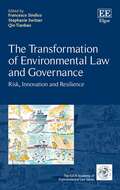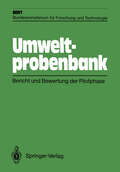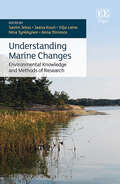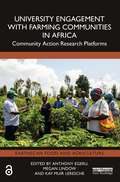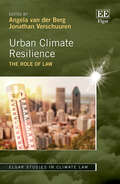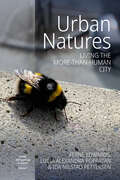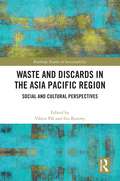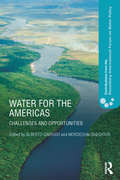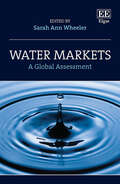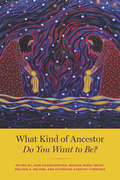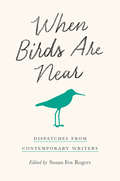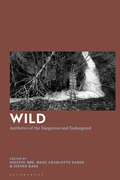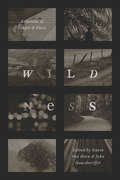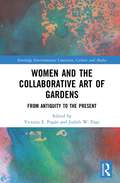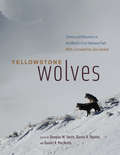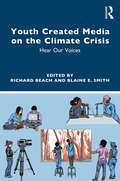- Table View
- List View
The Transformation of Environmental Law and Governance: Risk, Innovation and Resilience (The IUCN Academy of Environmental Law series)
This cutting-edge book considers the functional inseparability of risk and innovation within the context of environmental law and governance. Analysing both ‘hard’ and ‘soft’ innovation, the book argues that approaches to socio-ecological risk require innovation in order for society and the environment to become more resilient.In addition to risk and innovation, this book also highlights the need for resilience thinking in environmental law and governance, questioning whether these three factors are mutually supportive. Featuring wide geographical coverage of environmental law issues in both developing and developed nations, contributions posit that environmental law and governance is in a constant state of transformation. Throughout the book, discrete topics such as oceans, climate change and biodiversity are considered alongside intersecting themes such as human rights and litigation.Featuring up to date analysis of cutting edge topics by leading scholars in the field, The Transformation of Environmental Law and Governance will be a key resource for academics and students in the fields of environmental law, governance and regulation and environmental politics and policy. The valuable insights offered will also be beneficial for practitioners and lawmakers involved in the development of environmental law.
Umweltprobenbank: Bericht und Bewertung der Pilotphase
Schon Anfang der 70er Jahre, als in den Industriestaaten die Umweltpolitik eigenständige nationale und internationale politische Aufgabe wurde, ist dies seits und jenseits des Atlantiks die Idee geäußert worden, biologische Proben als Referenzmaterial für den Nachweis der Umweltbelastung früherer Zeiten zu nutzen. Die Väter der Idee, darunter vor allem Frederick Coulston, Albany Medical College, Albany NY, und Friedhelm Korte, Gesellschaft für Strahlen- und Umweltforschung, München, erkannten bald, daß ein Rückgriff auf naturkund liche Sammlungen von Gräsern, Schmetterlingen, Vogeleiern oder Fischen keine gültigen Rückschlüsse auf frühere Belastungen zulassen, da weder Kon servierungs- noch Lagerungsmethoden auf das Ziel einer rückschauenden Unter suchung angelegt waren. In der Bundesrepublik ergriff der Bundesminister für Forschung und Techno logie 1975 die Initiative und förderte das "Pilotprojekt Umweltprobenbank" . Die in der Bank aufbewahrten Proben sollen sowohl Auskunft über Konzentrationen von Umweltchemikalien in der Vergangenheit als auch auf Grund dann möglicher Trendaussagen Auskunft über künftige Belastungen geben. Das Pilotprojekt war so erfolgreich, daß die Bundesregierung im Jahre 1985 die Umweltprobenbank als permanente Einrichtung unter Leitung des Umweltbundesamtes geschaffen hat. Die Durchführung des Pilotprojektes war eine multidisziplinäre Aufgabe, an der Biologen, Chemiker, Mediziner, Bodenkundler sowie Tiefkühlungs- und EDV -Spezialisten zusammenwirkten. Dem Bundesminister für Forschung und Technologie, dem Bundesminister für Umwelt, Naturschutz und Reaktorsicherheit und allen am Pilotprojekt beteiligten Gruppen und Gutachtern sei für ihren Einsatz gedankt.
Understanding Marine Changes: Environmental Knowledge and Methods of Research
Studying environmental changes to the seas and oceans through a variety of perspectives and disciplines, this pioneering book outlines the challenges of researching marine environmental issues.With no linear cause-and-effect relationship between marine environmental changes and the often human-induced stressors which produce them, the changes to our seas and oceans are complex and uncertain, arising from multiple and interconnected issues. Bringing together academic expertise from different fields of study, this innovative book engages with stakeholders and branches of local ecological knowledge to address marine changes, outlining how they must be studied from multiple perspectives rather than a single academic discipline to reach effective solutions. Discussing marine interdisciplinarity in action, the book features international case studies from diverse fields across the ocean sciences, humanities and social sciences that explore art and science collaborations in practice.Showcasing the practical challenges and opportunities of such research, this will prove an invigorating read for students and scholars across such subject areas as environmental governance and regulation, marine and ocean sciences, sustainability studies and climate change. Its findings will also be of use to policymakers and practitioners concerned with marine changes across the world.
Understories: Plants and Culture in the American Tropics (American Tropics: Towards a Literary Geography #9)
Understories: Plants and Culture in the American Tropics establishes the central importance of plants to the histories and cultures of the extended tropical region stretching from the U.S. South to Argentina. Through close examination of a number of significant plants – cacao, mate, agave, the hevea brasilensis, kudzu, the breadfruit, soy, and the ceiba pentandra, among others – this volume shows that vegetal life has played a fundamental role in shaping societies and in formulating cultural and environmental imaginaries in and beyond the region. Drawing on a wide range of cultural traditions and forms across literature, popular music, art, and film, the essays included in this volume transcend regional and linguistic boundaries to bring together multiple plant-centred histories or ‘understories’ – narratives that until now have been marginalized or gone unnoticed. Attending not only to the significant influence of humans on plants, but also of plants on humans, this book offers new understandings of how colonization, globalization, and power were, and continue to be, imbricated with nature in the American tropics.
University Engagement with Farming Communities in Africa: Community Action Research Platforms (Earthscan Food and Agriculture)
This book explains and explores how collaborations can be built and strengthened between African universities and farming communities to address real-world contemporary challenges. The book focuses on Community Action Research Platforms, an approach that has successfully enabled African universities to break free of the ivory tower and prove their relevance to society through deep collaborative engagements in targeted agricultural value chains. Developed in a pan-African network of universities (RUFORUM) focused on capacity building in agriculture, the approach has been tested in diverse settings over the last 15 years. The book draws on the experiences and lessons from 21 different projects initiated by RUFORUM member universities in Benin, Botswana, Ethiopia, Ghana, Kenya, Malawi, Namibia, South Africa, Sudan, Tanzania, Uganda and Zimbabwe. It highlights a critical yet underutilised role for African universities as collaborators and catalysts for multisector solutions. These are solutions that increase productivity and address climate change. They develop livelihoods and resilience in rural communities, as well as promote farmers’ access to markets, innovation and trade while safeguarding biodiversity and enhancing food and nutrition security. The book makes a case for repositioning African universities as fulcrums of development in society. It shares the rich experiences, learnings and scientific findings of diverse researchers, practitioners and students who have been working towards achieving this reality on the ground. This multidisciplinary book holds appeal for university leaders, higher education, agrifood and development specialists, researchers and practitioners, policymakers and development agencies engaged in African agriculture and rural development, higher education and sustainable growth.
Urban Climate Resilience: The Role of Law (Elgar Studies in Climate Law)
This significant book addresses the most important legal issues that cities face when attempting to adapt to the changing climate. This includes how to become more resilient against the impacts of climate change such as sea level rise, increases in the intensity and frequency of storms, floods, droughts, and extreme temperatures.A range of expert contributors are brought together to assess the current state of climate change law and policy at the city level, featuring analysis of key legal instruments that can help urban societies adapt to, and cope with, the changing climate. Chapters contain comparative assessments of urban climate change policies in cities across the world, in both developed and developing countries, including Ghana, South Africa, Indonesia, the Netherlands and the US. Additionally, the book analyses legal approaches, relying on planning law and other legal instruments in the hands of city governments, which can aid in combating specific problems such as the urban heat island effect.Providing an up-to-date analysis of climate change adaptation and mitigation law at the level of cities, Urban Climate Resilience will be a key resource for academics and students of environmental law, public international law, urban planning and sustainability. The lessons for future policies and laws to create more climate resilient cities will also be useful for local policymakers, regulators and city government officials working on climate change at the local level.
Urban Environmental Education Review (Cornell Series in Environmental Education)
Urban Environmental Education Review explores how environmental education can contribute to urban sustainability. Urban environmental education includes any practices that create learning opportunities to foster individual and community well-being and environmental quality in cities. It fosters novel educational approaches and helps debunk common assumptions that cities are ecologically barren and that city people don't care for, or need, urban nature or a healthy environment.Topics in Urban Environmental Education Review range from the urban context to theoretical underpinnings, educational settings, participants, and educational approaches in urban environmental education. Chapters integrate research and practice to help aspiring and practicing environmental educators, urban planners, and other environmental leaders achieve their goals in terms of education, youth and community development, and environmental quality in cities.The ten-essay series Urban EE Essays, excerpted from Urban Environmental Education Review, may be found here: naaee.org/eepro/resources/urban-ee-essays. These essays explore various perspectives on urban environmental education and may be reprinted/reproduced only with permission from Cornell University Press.
Urban Natures: Living the More-than-Human City (Urban Anthropology Unbound #1)
Efforts to create greener urban spaces have historically taken many forms, often disorganized and undisciplined. Recently, however, the push towards greener cities has evolved into a more cohesive movement. Drawing from multidisciplinary case studies, Urban Natures examines the possibilities of an ethical lively multi-species city with the understanding that humanity’s relationship to nature is politically constructed. Covering a wide range of sectors, cities, and urban spaces, as well as topics ranging from edible cities to issues of power, and more-than-human methodologies, this volume pushes our imagination of a green urban future.
Valuing the Environment: Six case studies
The 'Pearce Report', Blueprint for a Green Economy, puts the role which monetary evaluation of environmental costs and benefit. can play firmly into the public eye. This book goes further and looks at six countries where such evaluation techniques are applied and at the obstacles to their further use. The case studies, written by leading experts in each nation, show how these methods are being taken up in the UK, Norway and Italy and the ways in which they are already extensively in use in the USA, Germany and the Netherlands. The authors also describe the obstacles to their use, the lack of knowledge of environmental economics at government level; the competition from other government priorities; the failure of environmental groups to grasp the importance of financial evaluation to their cause. But, as this book makes clear, significant advances are being made, both in the implementation of these economic techniques and, above all, in striking and yet further developments in economic thinking.
The Violence of Conservation in Africa: State, Militarization and Alternatives
Offering insights on violence in conservation in Africa, this timely book demonstrates how and why the state pursues conservation objectives to the detriment of its citizens. It focuses on how the dehumanization of black people and indigenous groups, the insertion of global green agendas onto the continent, a lack of resource sovereignty, and neoliberal conservation account for why violence is a permanent feature of conservation in Africa. Chapters uncover various forms of violence experienced on the continent, revealing the local and global conditions that enable them, and propose pathways towards non-violent conservation. The book concludes that the ideology of conservation is also an ideology about people. Crucially, it highlights the implications of increasing investment in violent instruments and the institutionalization of militarized approaches for conservation, the state, and ordinary people. Scholars and students of political ecology and environmental policy and planning will greatly benefit from this book’s drawing together of perspectives encompassing green violence and the militarization of conservation. It will also be an invigorating read for African studies researchers looking at coloniality and the re-evaluation of the African state, particularly through the lens of nature conservation.
Waste and Discards in the Asia Pacific Region: Social and Cultural Perspectives (Routledge Studies in Sustainability)
This book uncovers, explores and analyses the cultural and social factors and values that lie behind waste making, recycling and disposal in the Asia Pacific region, where impressive economic growth has led to significant increases in production, consumption and concomitant waste production. This volume demonstrates the immense scope of waste as a multi-sectoral phenomenon, covering discussions on food, menstrual products, sewage, electronics, scrap, nuclear waste, plastics, and even entire villages as they are submerged underwater by dam building, considered expendable in favour of economic growth. It discusses the wide range of approaches and contexts through which people interact with waste, including socio-economic analysis, participatory observation, laboratory science, art, video, installations, literature and photography. Case studies focusing on India, China and Japan, in addition to other regional examples, demonstrate the ubiquity of waste, materially and geographically. It examines the duality of waste management, fostering community building while simultaneously excluding marginalised groups; how it can be linked to efforts creating circular economies, to then reappear in oceanic garbage patches; or technical waste repurposed for high-tech laboratory research before being discarded once again. This timely and wide-ranging collection of essays will be an important read for scholars, researchers and students in sustainability, development studies, discard studies, and social and cultural history, particularly focusing on countries in the Asia-Pacific.
Water for the Americas: Challenges and Opportunities (Contributions from the Rosenberg International Forum on Water Policy)
The chapters in this volume are peer reviewed editions of the papers presented at the 7th meeting of the Rosenberg International Forum on Water Policy which was held in Buenos Aires, Argentina on November 15-17, 2010. The theme for Forum VII was Water for the Americas: Challenges and Opportunities. This Forum was unique in examining the water problems of the Americas and identifying water management experience gleaned in other parts of the world that might be useful in addressing the problems of the Americas. The sessions illustrated how the water problems of the Americas are common problems, differing only in degree from basin to basin. There was unanimity among the participants about the need for all inhabitants of the Americas to work together to ensure that everyone has access to adequate quantities of healthy water supplies and to appropriate sanitation services. This volume’s approach is to identify different responses and policies that address common issues and learn from contrasts and experiences. The value and potential that this approach affords is that it provides critical judgments about what has worked well and what needs to be done to gain a better future for the Americas’ water resources and society. Some issues covered in the volume are so pressing and urgent, chief among them is serving the unserved, that any delays putting out new facilities in many a rural areas of Central America may cost lives and reduce the outlook for children. Additionally, the volume makes clear that the outlook for the poorest and the future of hundreds of growing cities are threatened by climate change. This book looks into the future by analyzing present and relevant data and gains insight from the different developmental stages of the hemisphere.
Water Markets: A Global Assessment
Exploring water scarcity issues in light of the growing crisis in global water management, this book examines the applicability of water markets. It provides an overview and understanding of the presence of water markets across the globe, analysing the ways in which different countries and regions are grappling with water scarcity. This timely book offers an insight into the benefits of water markets, and their identified market failures. A water market framework is applied to key case studies, highlighting that the majority of regions have not had sufficient water reforms to allow for the introduction of water markets without negative social consequences. The book addresses existing hydrological and institutional capacity across countries and areas where water reform is needed, and lessons are provided for future water markets, taking into account these limitations. The case studies of different countries tackling water scarcity issues and reform will make this an essential read for scholars of environmental studies, water economics, sustainability management and environmental policies. It will also be an invigorating book for water policy-makers interested in lessons for change, and in how to better implement reforms for water markets to help address both water scarcity and improve productivity.
What Kind of Ancestor Do You Want to Be?
As we face an ever-more-fragmented world, What Kind of Ancestor Do You Want to Be? demands a return to the force of lineage—to spiritual, social, and ecological connections across time. It sparks a myriad of ageless-yet-urgent questions: How will I be remembered? What traditions do I want to continue? What cycles do I want to break? What new systems do I want to initiate for those yet-to-be-born? How do we endure? Published in association with the Center for Humans and Nature and interweaving essays, interviews, and poetry, this book brings together a thoughtful community of Indigenous and other voices—including Linda Hogan, Wendell Berry, Winona LaDuke, Vandana Shiva, Robin Kimmerer, and Wes Jackson—to explore what we want to give to our descendants. It is an offering to teachers who have come before and to those who will follow, a tool for healing our relationships with ourselves, with each other, and with our most powerful ancestors—the lands and waters that give and sustain all life.
When Birds Are Near: Dispatches from Contemporary Writers
In this dazzling literary collection, writers explore and celebrate their lives with and love for birds—detailing experiences from Alaska to Bermuda, South Dakota to Panama. In When Birds Are Near, fresh new voices as well as seasoned authors offer tales of adventure, perseverance, and fun, whether taking us on a journey down Highway 1 to see a rare California Condor, fighting the destruction of our grasslands, or simply watching the feeder from a kitchen window.But these essays are more than just field notes. The authors reflect on love, loss, and family, engaging a broad array of emotions, from wonder to amusement. As Rob Nixon writes, "Sometimes the best bird experiences are defined less by a rare sighting than by a quality of presence, some sense of overall occasion that sets in motion memories of a particular landscape, a particular light, a particular choral effect, a particular hiking partner." Or, as the poet Elizabeth Bradfield remarks, "We resonate with certain animals, I believe, because they are a physical embodiment of an answer we are seeking. A sense of ourselves in the world that is nearly inexpressible." When Birds Are Near gives us the chance to walk alongside these avid appreciators of birds and reflect on our own interactions with our winged companions.Contributors: Christina Baal, Thomas Bancroft, K. Bannerman, R. A. Behrstock, Richard Bohannon, Elizabeth Bradfield, Christine Byl, Susan Cerulean, Sara Crosby, Jenn Dean, Rachel Dickinson, Katie Fallon, Jonathan Franzen, Andrew Furman, Tim Gallagher, David Gessner, Renata Golden, Ursula Murray Husted, Eli J. Knapp, Donald Kroodsma, J. Drew Lanham, John R. Nelson, Rob Nixon, Jonathan Rosen, Alison Townsend, Alison Világ
When Fracking Comes to Town: Governance, Planning, and Economic Impacts of the US Shale Boom
When Fracking Comes to Town traces the response of local communities to the shale gas revolution. Rather than cast communities as powerless to respond to oil and gas companies and their landmen, it shows that communities have adapted their local rules and regulations to meet the novel challenges accompanying unconventional gas extraction through fracking. The multidisciplinary perspectives of this volume's essays tie together insights from planners, legal scholars, political scientists, and economists. What emerges is a more nuanced perspective of shale gas development and its impacts on municipalities and residents. Unlike many political debates that cast fracking in black-and-white terms, this book's contributors embrace the complexity of local responses to fracking. States adapted legal institutions to meet the new challenges posed by this energy extraction process while under-resourced municipal officials and local planning offices found creative ways to alleviate pressure on local infrastructure and reduce harmful effects of fracking on the environment. The essays in When Fracking Comes to Town tell a story of community resilience with the rise and decline of shale gas production. Contributors: Ennio Piano, Ann M. Eisenberg, Pamela A. Mischen, Joseph T. Palka, Jr., Adelyn Hall, Carla Chifos, Teresa Córdova, Rebecca Matsco, Anna C. Osland, Carolyn G. Loh, Gavin Roberts, Sandeep Kumar Rangaraju, Frederick Tannery, Larry McCarthy, Erik R. Pages, Mark C. White, Martin Romitti, Nicholas G. McClure, Ion Simonides, Jeremy G. Weber, Max Harleman, Heidi Gorovitz Robertson
Wild: Aesthetics of the Dangerous and Endangered
In this interdisciplinary work, philosophers from different specialisms connect with the notion of the wild today and interrogate how it is mediated through the culture of the Anthropocene. They make use of empirical material like specific artworks, films and other cultural works related to the term 'wild' to consider the aesthetic experience of nature, focusing on the untamed, the boundless, the unwieldy, or the unpredictable; in other words, aspects of nature that are mediated by culture. This book maps out the wide range of ways in which we experience the wildness of nature aesthetically, relating both to immediate experience as well as to experience mediated through cultural expression. A variety of subjects are relevant in this context, including aesthetics, art history, theology, human geography, film studies, and architecture. A theme that is pursued throughout the book is the wild in connection with ecology and its experience of nature as both a constructive and destructive force.
Wildness: Relations of People and Place
Whether referring to a place, a nonhuman animal or plant, or a state of mind, wild indicates autonomy and agency, a will to be, a unique expression of life. Yet two contrasting ideas about wild nature permeate contemporary discussions: either that nature is most wild in the absence of a defiling human presence, or that nature is completely humanized and nothing is truly wild. This book charts a different path. Exploring how people can become attuned to the wild community of life and also contribute to the well-being of the wild places in which we live, work, and play, Wildness brings together esteemed authors from a variety of landscapes, cultures, and backgrounds to share their stories about the interdependence of everyday human lifeways and wildness. As they show, far from being an all or nothing proposition, wildness exists in variations and degrees that range from cultivated soils to multigenerational forests to sunflowers pushing through cracks in a city alley. Spanning diverse geographies, these essays celebrate the continuum of wildness, revealing the many ways in which human communities can nurture, adapt to, and thrive alongside their wild nonhuman kin. From the contoured lands of Wisconsin’s Driftless region to remote Alaska, from the amazing adaptations of animals and plants living in the concrete jungle to indigenous lands and harvest ceremonies, from backyards to reclaimed urban industrial sites, from microcosms to bioregions and atmospheres, manifestations of wildness are everywhere. With this book, we gain insight into what wildness is and could be, as well as how it might be recovered in our lives—and with it, how we might unearth a more profound, wilder understanding of what it means to be human. Wildness: Relations of People and Place is published in association with the Center for Humans and Nature, an organization that brings together some of the brightest minds to explore and promote human responsibilities to each other and the whole community of life. Visit the Center for Humans and Nature's Wildness website for upcoming events and a series of related short films.
Women and the Collaborative Art of Gardens: From Antiquity to the Present (Routledge Environmental Literature, Culture and Media)
Women and the Collaborative Art of Gardens explores the garden and its agency in the history of the built and natural environments, as evidenced in landscape architecture, literature, art, archaeology, history, photography, and film. Throughout the book, each chapter centers the act of collaboration, from garden clubs of the early twentieth century as powerful models of women’s leadership, to the more intimate partnerships between family members, to the delicate relationship between artist and subject. Women emerge in every chapter, whether as gardeners, designers, owners, writers, illustrators, photographers, filmmakers, or subjects, but the contributors to this dynamic collection unseat common assumptions about the role of women in gardens to make manifest the significant ways in which women write themselves into the accounts of garden design, practice, and history. The book reveals the power of gardens to shape human existence, even as humans shape gardens and their representations in a variety of media, including brilliantly illuminated manuscripts, intricately carved architectural spaces, wall paintings, black and white photographs, and wood cuts. Ultimately, the volume reveals that gardens are best apprehended when understood as products of collaboration. The book will be of interest to scholars and students of gardens and culture, ancient Rome, art history, British literature, medieval France, film studies, women’s studies, photography, African American Studies, and landscape architecture.
World Review: Environmental and Sustainability Education in the Context of the Sustainable Development Goals
The global landscape of education has been reshaped by the COVID-19 pandemic, revealing the various challenges faced by countries worldwide. This book provides a comprehensive exploration of Environmental and Sustainability Education (ESE) across different countries, offering unique insights into their histories, challenges, achievements, and future ESE needs. From Africa to Oceania, the book delves into the vital role of ESE in the context of the UN Sustainable Development Goals. It highlights the diverse national discourses and the flexibility required to deliver effective global education programs. ESE practitioners, researchers, and policymakers worldwide will find inspiration and invaluable perspectives in this book.
Yellowstone Wolves: Science and Discovery in the World's First National Park
In 2020, it will have been twenty-five years since one of the greatest wildlife conservation and restoration achievements of the twentieth century took place: the reintroduction of wolves to the world’s first national park, Yellowstone. Eradicated after the park was established, then absent for seventy years, these iconic carnivores returned to Yellowstone in 1995 when the US government reversed its century-old policy of extermination and—despite some political and cultural opposition—began the reintroduction of forty-one wild wolves from Canada and northwest Montana. In the intervening decades, scientists have studied their myriad behaviors, from predation to mating to wolf pup play, building a one-of-a-kind field study that has both allowed us to witness how the arrival of top predators can change an entire ecosystem and provided a critical window into impacts on prey, pack composition, and much else. Here, for the first time in a single book, is the incredible story of the wolves’ return to Yellowstone National Park as told by the very people responsible for their reintroduction, study, and management. Anchored in what we have learned from Yellowstone, highlighting the unique blend of research techniques that have given us this knowledge, and addressing the major issues that wolves still face today, this book is as wide-ranging and awe-inspiring as the Yellowstone restoration effort itself. We learn about individual wolves, population dynamics, wolf-prey relationships, genetics, disease, management and policy, newly studied behaviors and interactions with other species, and the rippling ecosystem effects wolves have had on Yellowstone’s wild and rare landscape. Perhaps most importantly of all, the book also offers solutions to ongoing controversies and debates. Featuring a foreword by Jane Goodall, beautiful images, a companion online documentary by celebrated filmmaker Bob Landis, and contributions from more than seventy wolf and wildlife conservation luminaries from Yellowstone and around the world, Yellowstone Wolves is a gripping, accessible celebration of the extraordinary Yellowstone Wolf Project—and of the park through which these majestic and important creatures once again roam.
Youth Created Media on the Climate Crisis: Hear Our Voices
This timely book provides effective methods and authentic examples of teaching about climate change through digital and multimodal media production in the English Language Arts classroom. The chapters in this edited volume demonstrate the benefits of addressing climate change in the classroom through innovative media production and cover a range of different types of media, including video/digital storytelling, social media, art, music, and writing, with rich resources for instruction in every chapter. Through the engaging ideas and strategies, the contributors equip educators with the critical tools for supporting students’ media production. In so doing, they offer new perspectives on how students can employ media and production techniques to critique the status quo, call for change, and acquire new literacy skills. As the effects of the climate crisis become increasingly visible to the youth population, this book helps foster and support youth agency and activism. Youth Media Creation on the Climate Change Crisis: Hear Our Voices is a necessary text for students, preservice teachers, and educators in literacy education, media studies, social and environmental studies, and STEM education. The eBook+ version of the text features embedded audio and video components as well as interactive links to reflect the multimodal nature of students’ work, spotlighting how youth media production supports the development of students’ critical literacy skills and shapes their voices and identities.
